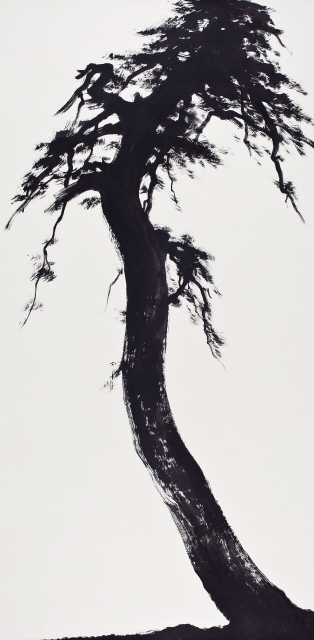Pine trees are so common in Korea that Koreans use parts of the tree such as the needles and pollen for special dishes, as well as the timber for numerous purposes. But in the hands of Moon Bong-sun, an oriental painter who strives to preserve traditional drawing techniques and brush strokes, they each become one of a kind.
Seoul Museum presents 20 ink-and-wash paintings of pine trees by Moon. The large pine tree paintings overwhelm viewers with their scale and symbolism.
Pine trees represent some of the key Confucian values that have been cherished by Koreans for centuries such as dignity, integrity and fidelity. The tree was one of the most popular objects for prominent painters in Joseon such as Kim Jeong-hee, Jeong Seon and Kim Hong-do.
 |
“Pine Tree — Gangneung Chodang Pine Tree Forest” by Moon Bong-sun (Seoul Museum) |
Moon portrays the significance of pine trees in the Korean mentality through subtle nuances of ink and brush strokes.
Titled with the old expression “Dokyacheongcheong” that describes an integrity that resists outside influences, a straight, solid pine tree drawn with bold and fast brush strokes becomes a symbol of Confucian values.
Moon also pays attention to the curved ones by shores that have endured heavy winds and drastic weather changes for hundreds of years, as if practicing endurance and patience, other important values.
 |
“Pine Tree - Dokyacheongcheong” by Moon Bong-sun (Seoul Museum) |
As most of the paintings are drawn on hanji paper, a painting featuring two pine trees in snow at dawn is beautifully done with different ink shades on a mulberry paper.
A large piece that takes up the entire wall of an exhibition section features pine tree forests that Moon visited in Gangneung and Gyeongju. With simple techniques, he creates perspective that makes viewers feel like they are stepping into the forest.
According to a museum curator, Moon’s brush strokes don’t just enlighten viewers with the beauty of Korean nature, but have a modernized style that has connections with beauty in abstract paintings in contemporary art.
One of the pine tree paintings features a “thousand-year-old tree,” deep-rooted in the garden of Seokpajeong ― the historic villa of Heungseon Daewongun, Korea’s late 19th-century prince regent ― which now sits on the top floor of the museum.
Moon spent years making trips across the country in search of the natural beauty of the Korean Peninsula to develop his unique pine tree painting style.
The artist never leaves his home without a sketchbook, pencils, brushes and Korean “meok” ink stone, but leaves his camera at home for a “real” documentation of nature.
The exhibition “Pine Tree: Looking Ahead 1,000 Years” continues through Feb. 17, 2013, at Seoul Museum in Buam-dong, Seoul.
For more information, call (02) 395-0238.
By Lee Woo-young (
wylee@heraldcorp.com)







![[Herald Interview] 'Trump will use tariffs as first line of defense for American manufacturing'](http://res.heraldm.com/phpwas/restmb_idxmake.php?idx=644&simg=/content/image/2024/11/26/20241126050017_0.jpg)
![[Exclusive] Hyundai Mobis eyes closer ties with BYD](http://res.heraldm.com/phpwas/restmb_idxmake.php?idx=644&simg=/content/image/2024/11/25/20241125050044_0.jpg)
